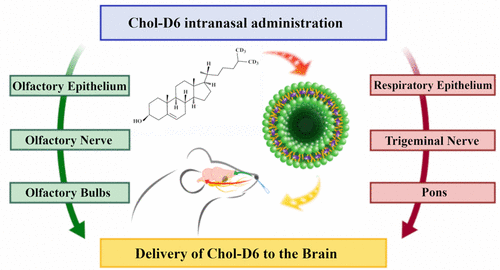当前位置:
X-MOL 学术
›
ACS Chem. Neurosci.
›
论文详情
Our official English website, www.x-mol.net, welcomes your feedback! (Note: you will need to create a separate account there.)
Efficacy of Cholesterol Nose-to-Brain Delivery for Brain Targeting in Huntington's Disease.
ACS Chemical Neuroscience ( IF 5 ) Pub Date : 2020-01-07 , DOI: 10.1021/acschemneuro.9b00581 Alice Passoni 1 , Monica Favagrossa 1 , Laura Colombo 1 , Renzo Bagnati 1 , Marco Gobbi 1 , Luisa Diomede 1 , Giulia Birolini 2, 3 , Eleonora Di Paolo 2, 3 , Marta Valenza 2, 3 , Elena Cattaneo 2, 3 , Mario Salmona 1
ACS Chemical Neuroscience ( IF 5 ) Pub Date : 2020-01-07 , DOI: 10.1021/acschemneuro.9b00581 Alice Passoni 1 , Monica Favagrossa 1 , Laura Colombo 1 , Renzo Bagnati 1 , Marco Gobbi 1 , Luisa Diomede 1 , Giulia Birolini 2, 3 , Eleonora Di Paolo 2, 3 , Marta Valenza 2, 3 , Elena Cattaneo 2, 3 , Mario Salmona 1
Affiliation

|
The current pharmacological treatment of Huntington's disease (HD) is palliative, and therapies to restore functions in patients are needed. One of the pathways affected in HD involves brain cholesterol (Chol) synthesis, which is essential for optimal synaptic transmission. Recently, it was reported that in a HD mouse model, the delivery of exogenous Chol to the brain with brain-permeable nanoparticles protected animals from cognitive decline and rescued synaptic communication, indicating Chol as a therapeutic candidate. We examined whether nose-to-brain delivery, already used in human therapy, could be an alternative, noninvasive strategy to deliver Chol to the adult brain and, in the future, replenish Chol in the HD brain. We gave wild-type (WT) mice a single intranasal (IN) dose of liposomes loaded with deuterium-labeled cholesterol (Chol-D6, to distinguish and quantify the exogenous cholesterol from the native one) (200 μg Chol-D6/dose). After different intervals, Chol-D6 levels, determined by LC-MS in plasma, striatum, cortex, and cerebellum, reached a steady-state concentration of 0.400 ng/mg between 24 and 72 h. A subsequent acute study confirmed the kinetic profiles of Chol-D6 in all tissues, indicating correspondence between the dose (two doses of 200 μg Chol-D6/dose) and the calculated brain area concentration (0.660 ng/mg). Finally, in WT mice given repeated IN doses, the average Chol-D6 level after 24 h was about 1.5 ng/mg in all brain areas. Our data indicate the effectiveness of IN Chol-loaded liposomes to deliver Chol in different brain regions, opening the way to future investigations in HD mice.
中文翻译:

胆固醇从鼻到脑的递送对亨廷顿氏病的脑靶向治疗。
亨廷顿舞蹈病(HD)的当前药物治疗是姑息治疗,需要用于恢复患者功能的疗法。HD中受影响的途径之一涉及脑胆固醇(Chol)的合成,这对于最佳的突触传递至关重要。最近,有报道称,在HD小鼠模型中,外源Chol与可渗透脑的纳米颗粒向大脑的传递保护了动物免受认知能力下降和突触通讯的恢复,表明Chol是治疗的候选药物。我们检查了已经用于人类治疗的从鼻到脑的输送是否可以作为将Chol输送到成人大脑并在将来补充HD大脑中的Chol的另一种非侵入性策略。我们给野生型(WT)小鼠鼻内(IN)剂量的脂质体,其中装有氘标记的胆固醇(Chol-D6,以区分和定量天然胆固醇与外源性胆固醇)(200μgChol-D6 /剂量) 。在不同的时间间隔后,通过LC-MS测定的血浆,纹状体,皮质和小脑中的Chol-D6水平在24至72小时之间达到0.400 ng / mg的稳态浓度。随后的一项急性研究证实了Chol-D6在所有组织中的动力学特征,表明剂量(两次剂量200μgChol-D6 /剂量)与计算出的脑区域浓度(0.660 ng / mg)之间存在对应关系。最后,在给予重复IN剂量的WT小鼠中,所有脑区域在24小时后的平均Chol-D6水平约为1.5 ng / mg。我们的数据表明IN载有Chol的脂质体在不同脑区递送Chol的有效性,
更新日期:2020-01-07
中文翻译:

胆固醇从鼻到脑的递送对亨廷顿氏病的脑靶向治疗。
亨廷顿舞蹈病(HD)的当前药物治疗是姑息治疗,需要用于恢复患者功能的疗法。HD中受影响的途径之一涉及脑胆固醇(Chol)的合成,这对于最佳的突触传递至关重要。最近,有报道称,在HD小鼠模型中,外源Chol与可渗透脑的纳米颗粒向大脑的传递保护了动物免受认知能力下降和突触通讯的恢复,表明Chol是治疗的候选药物。我们检查了已经用于人类治疗的从鼻到脑的输送是否可以作为将Chol输送到成人大脑并在将来补充HD大脑中的Chol的另一种非侵入性策略。我们给野生型(WT)小鼠鼻内(IN)剂量的脂质体,其中装有氘标记的胆固醇(Chol-D6,以区分和定量天然胆固醇与外源性胆固醇)(200μgChol-D6 /剂量) 。在不同的时间间隔后,通过LC-MS测定的血浆,纹状体,皮质和小脑中的Chol-D6水平在24至72小时之间达到0.400 ng / mg的稳态浓度。随后的一项急性研究证实了Chol-D6在所有组织中的动力学特征,表明剂量(两次剂量200μgChol-D6 /剂量)与计算出的脑区域浓度(0.660 ng / mg)之间存在对应关系。最后,在给予重复IN剂量的WT小鼠中,所有脑区域在24小时后的平均Chol-D6水平约为1.5 ng / mg。我们的数据表明IN载有Chol的脂质体在不同脑区递送Chol的有效性,



























 京公网安备 11010802027423号
京公网安备 11010802027423号